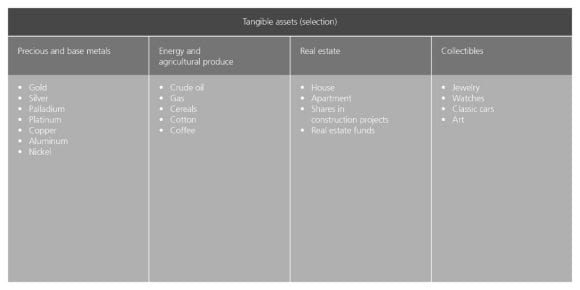Assets
Diversify your portfolio with tangible assets
Want to invest in tangible assets? From precious metals and commodities to real estate: get to know popular tangible assets.

![]()
header.search.error
Assets
Want to invest in tangible assets? From precious metals and commodities to real estate: get to know popular tangible assets.

The main points in a nutshell
What are tangible assets?
Tangible assets are generally material goods that exist physically and which have a real (material) value. They are said to offer some protection against inflation because they are less dependent on monetary value. As they exist physically, they have an intrinsic or material value.
If, for example, the monetary value decreases, this has a limited effect on the intrinsic value of a property. Tangible assets are not as susceptible to changes in interest rates and developments on the market as stocks and bonds. Investments in tangible assets therefore help diversify a portfolio. However, there are a few important points to be aware of.
What are the most common tangible assets?

Investing in art or collectibles is usually something for enthusiastic and experienced investors. In addition to luxury items such as watches and jewelry, classic cars are also popular collectors’ items The challenge with these tangible assets is that the actual material value often bears little relation to the purchase price.
If you acquire a collector’s item as an investment, you are speculating that the object will achieve the value of a collector’s item over time and thus can be sold at a higher price.
What are the advantages of tangible assets?
In an investment context, diversification is one of the major benefits of tangible assets. The physical attributes of tangible assets are a major differentiator from non-tangible assets, such as shares or bonds. This results in different drivers for changes in value. In times of crisis, the value of gold is a good illustration – while the stock market tends to fall during periods of turbulence, gold often gains in value, or its losses are more limited. This allows for greater risk diversification for your portfolio.
Tangible assets have a specific intrinsic value and in most cases at least a minimum material value – regardless of exchange rates or money. This means your assets are protected to a certain degree. Whereas money and investments that are not tied to a physical value lose value in real terms in the event of positive inflation, tangible assets, such as real estate, can often resist devaluation for longer or are exposed to other mechanisms.
As tangible products, tangible assets can also serve investors’ own use or enjoyment – such as a house or a painting, for example.
What are the drawbacks of tangible assets?
Exchange rate fluctuations do not affect tangible assets per se. However, since tangible assets are often traded in forward contracts and certain types of commodities are traded in a major currency such as US dollars, currency risk comes into play.
Example: You buy a gold bar in US dollars at the exchange rate of 0.95 USD/CHF. When you want to sell the gold bar a month later, the exchange rate has dropped to 0.90 USD/CHF. You therefore incur a loss due to the exchange rate.
The price of tangible assets is not always completely transparent and requires expertise, especially in the case of goods that are not traded on exchanges or similar platforms. For example, inexperienced investors cannot tell the value of a work of art directly. They could fall into price traps when trading.
Because a personal conversation is worth a lot
What can we do for you? We’re happy to address your concerns directly. You can contact us in the following ways: